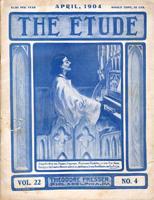Translated from the French of Jean d'Udine by Florence Leonard.
[We reprint the following from Le Courrier Musical, of Paris, one of a series of letters to young students.—Editor.]
My dear: In my last letter I tried to show you that style results from choosing; an artist—or the people of a certain period of time—chooses some colors or shapes or ways of arranging his materials and leaves out others that he might have taken. What he has chosen produces his style. That is easy to understand when we speak of painting, but what about music?
In the first place you must remember that there are two very different kinds of music. One kind is called "imitative," and that, as you may guess, tries to copy or imitate exactly sounds of nature, noises even—the sound of a brook, the bleating of sheep, the wind, the church-bells. This is not true music, and we find very little of it in the works of our great masters.
The other kind of music we will call "expressive" (the name in the books you will read is "absolute," and that expresses feeling). In this music we find, nine times out of ten, only the conventional representation of human feelings—joy, grief, love, hate, hope, wrath, and so on. When I say "conventional," I mean this: with a certain arrangement of notes, a certain curve of melody, certain chords, one can always obtain this or that effect, and I could name for you famous musicians who have pretended to express in this way passion or grief or enthusiasm, when really they had none of these feelings at all when they were writing.
"But," you will ask me, "how can we tell that some musical characters will express our own feelings and others will not? My little troubles don't sing in D Minor, nor my little pleasures dance Allegro.
Yes; they surely do, my dear little friend. When you are happy at the thought of the visit Elise is going to make you, or when you are provoked because you have to wear that hat that you dislike, your satisfaction and your displeasure contain, hidden away, musical forms and rhythms and melodies different from the usual rhythm, the large symphonic whole of your life in general. Now the real musicians are those who know how to present each one of their emotions in harmony, form, and movement that belong distinctly to that one emotion and not to any others.
"But," you will ask again, "how can we judge whether the composer has chosen correctly and expressed his own feelings? Perhaps he has used any rhythm and chords he happened to think of; there are thousands to choose from."
Well, in the first place, I shall answer by saying that after a little practice we learn to recognize, instinctively, the music that has personality in it, even if we hear only a single page by a writer we never have known before.
But there is a test that almost never fails us. To test the style of a piece of music you must see whether all the parts of it are expressive, all the materials, all the devices; whether they are all necessary to make the perfect whole; whether there is anything awkward or superfluous, in a word, anything in it worthless, useless, out of place, empty.
"What are the elements or materials or devices?" do you ask?
The primary elements of music (which I shall analyze further for you in another letter) are the Rhythm or movement, the Melody or curves of line, and the Color or the atmosphere of sound. This last depends sometimes on the instruments that are playing, sometimes on the chords, sometimes on just the melody. In most music these three elements are combined; indeed, Melody and Rhythm are almost inseparable, but one element can have more importance than another in a certain piece. I will give you some examples from Schumann's "Jugend Album." In No. 12, Knecht Ruprecht; No. 23, Reiterstück; No. 25, Nachklänge aus dem Theater; No. 29., Fremder Mann, the rhythm is the strongest element. In contrast to these are No. 16, Erster Verlust, and No. 28, Erinnerung, for there the beauty lies in the lovely curve of the melodies. Look at the second part of No. 20, Ländliches Lied, and of No. 21, which has no title; here we are charmed by the color which lies in the harmony, while in No. 37, Matrosenlied, and No. 39, Winterszeit, remarkable for their severe and rich coloring, this atmosphere is produced by the melody in which color is stronger in effect than smoothness of line. Schumann is fond of that sort of melody.
But one more remark about the "Jugend Album." If you look all through it, or open anywhere you will, you will surely find that style, as I have just defined it, is stamped on every page; nowhere will you find a useless note, an arbitrary or haphazard rhythm, a flat chord.
In truth, you are just a little bewildered by such substantial music. In your favorite Fantasies the time—as you would say—is easy and flowing; it does no harm to skip a few notes occasionally, and the chords are only to fill in, not part of the tune.
You are used to pieces with much repetition in them. They seem brilliant, if one doesn't notice especially, and so pieces which are closely built and full of distinct meaning seem to you thin and vague— just the opposite. But you will change your mind when you begin to see what rare exquisite essences Schumann has distilled in this little collation.
"Distilled?" Yes, distilling is like creating style in music, where the composer separates certain elements of Rhythm, Melody, and Harmony from other properties of sounds, by means of the wonderful heat that we call Inspiration.



